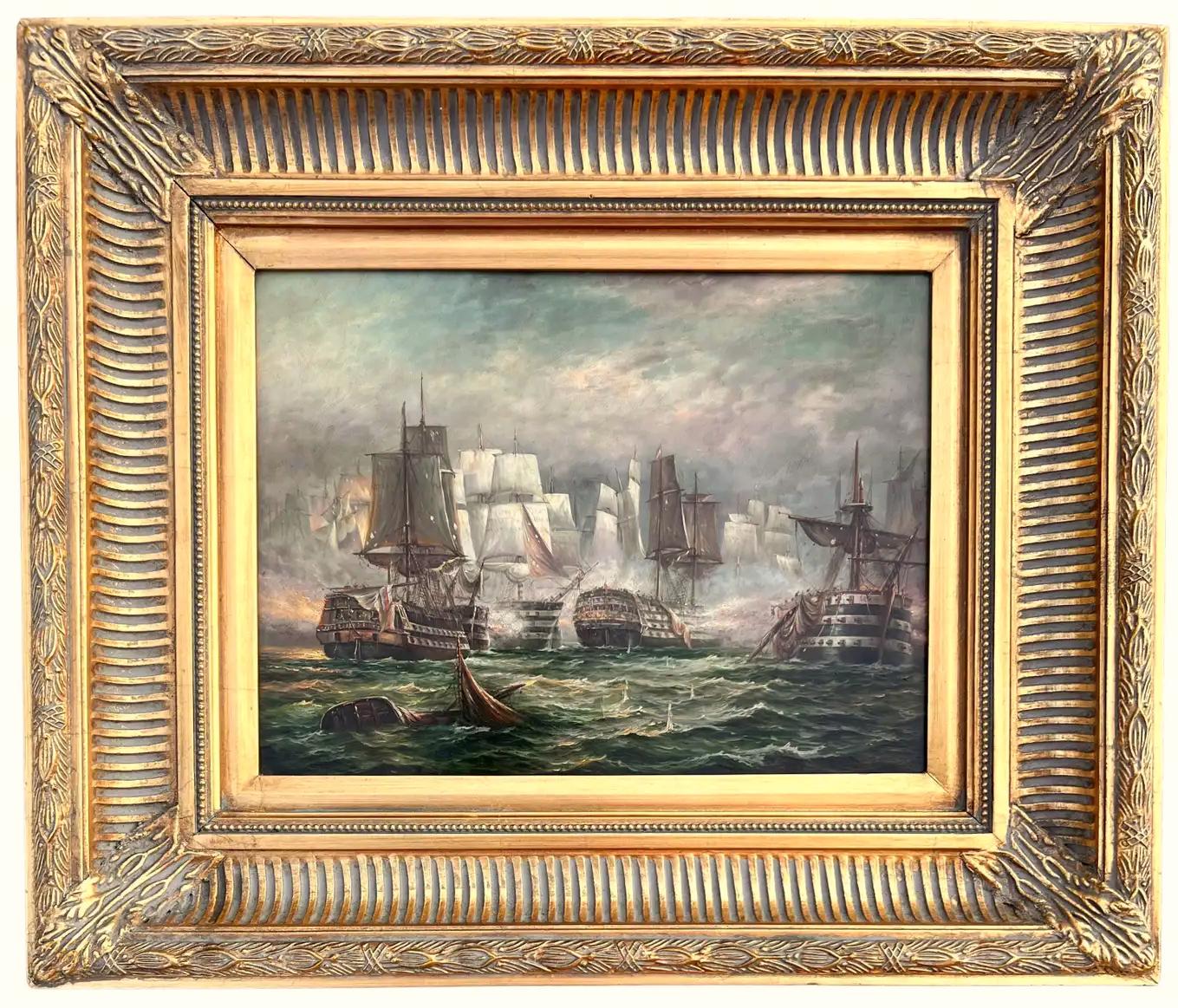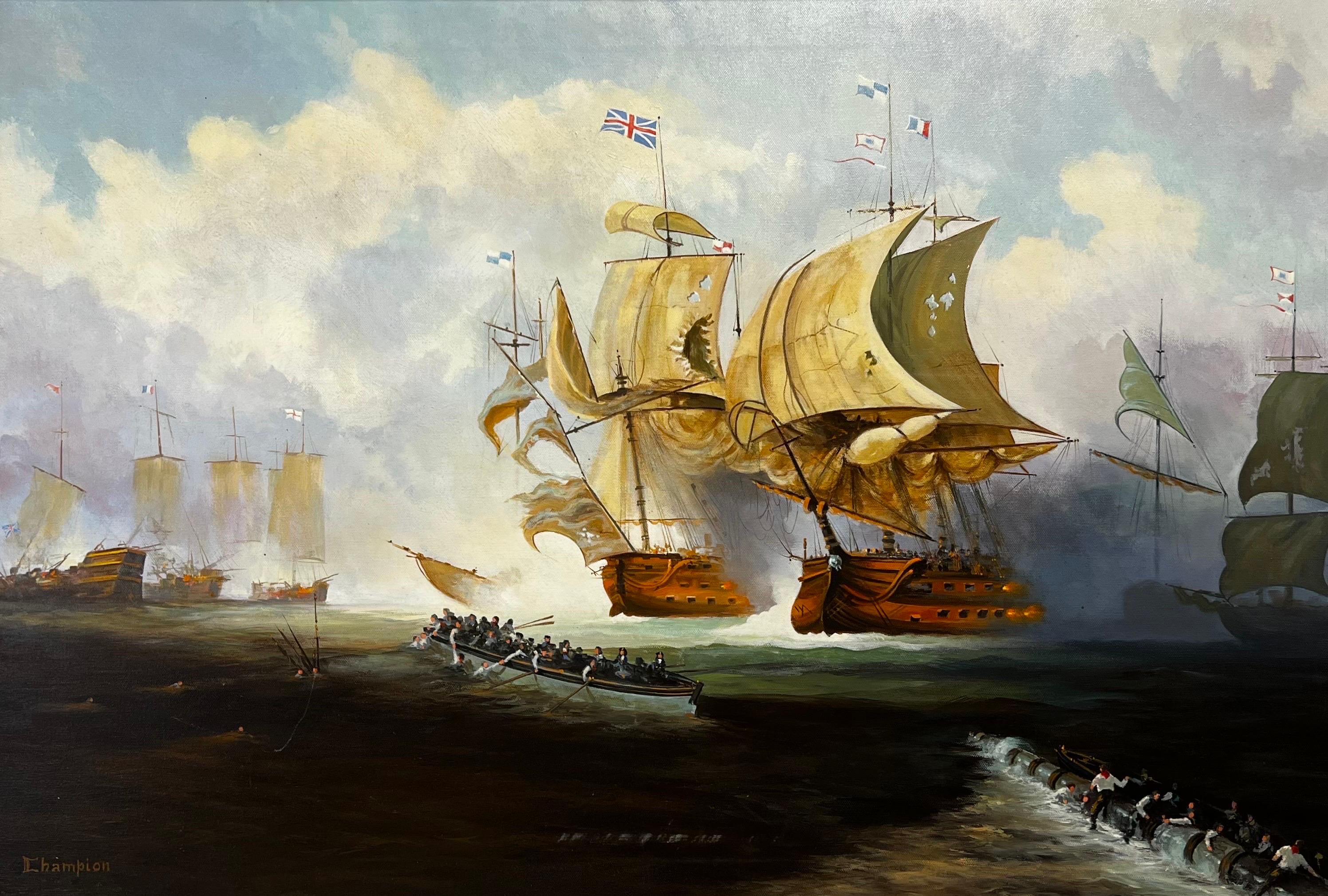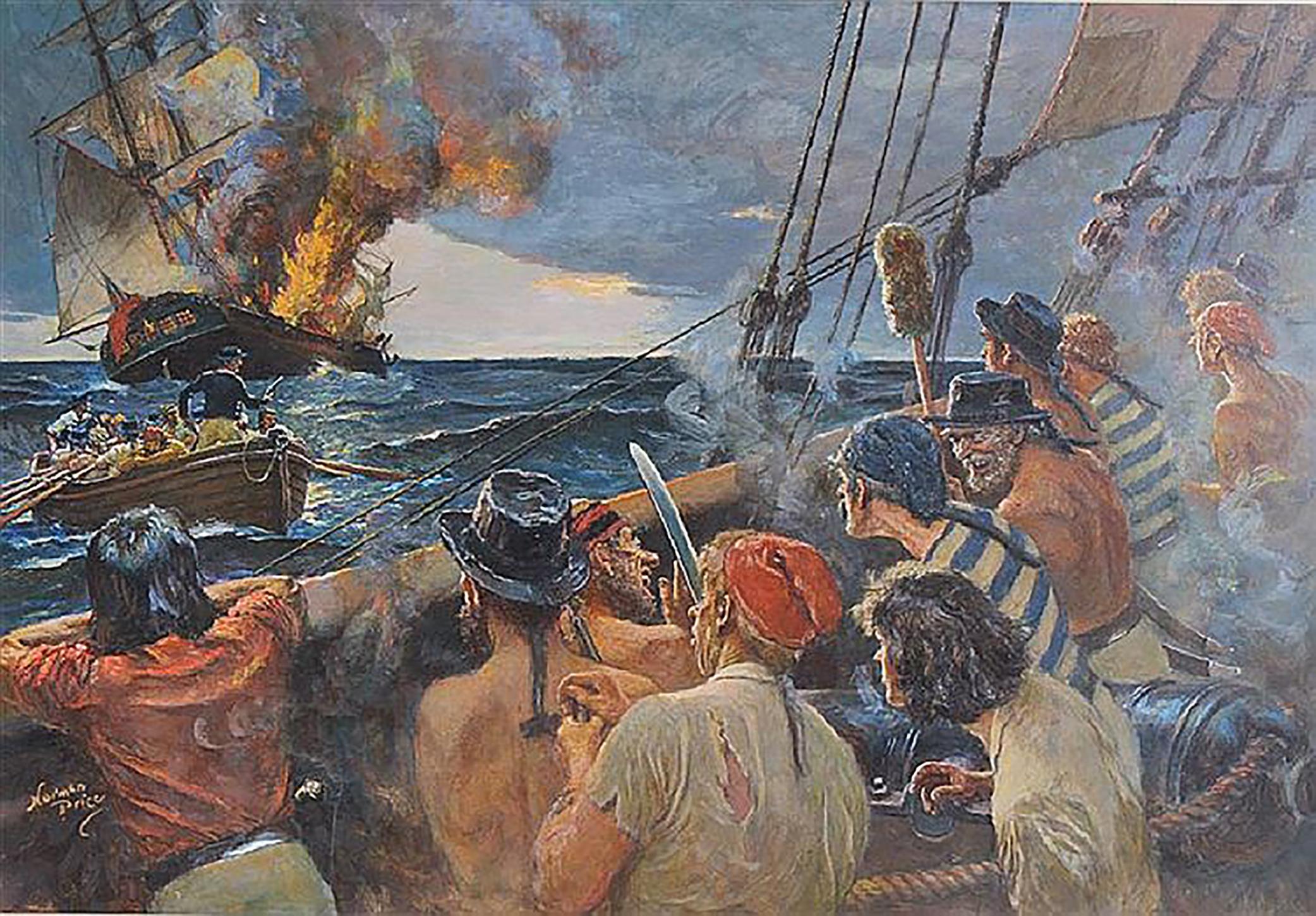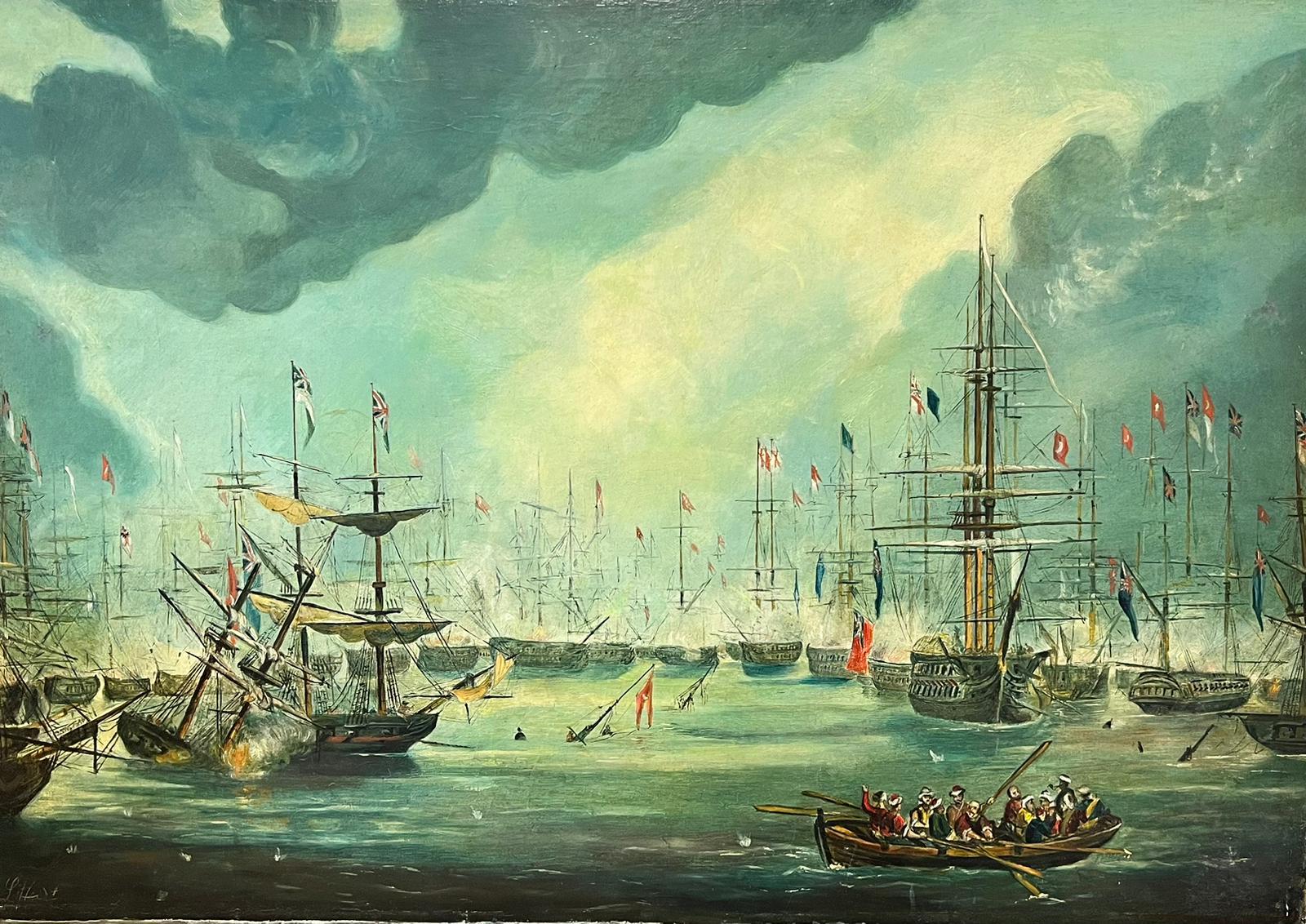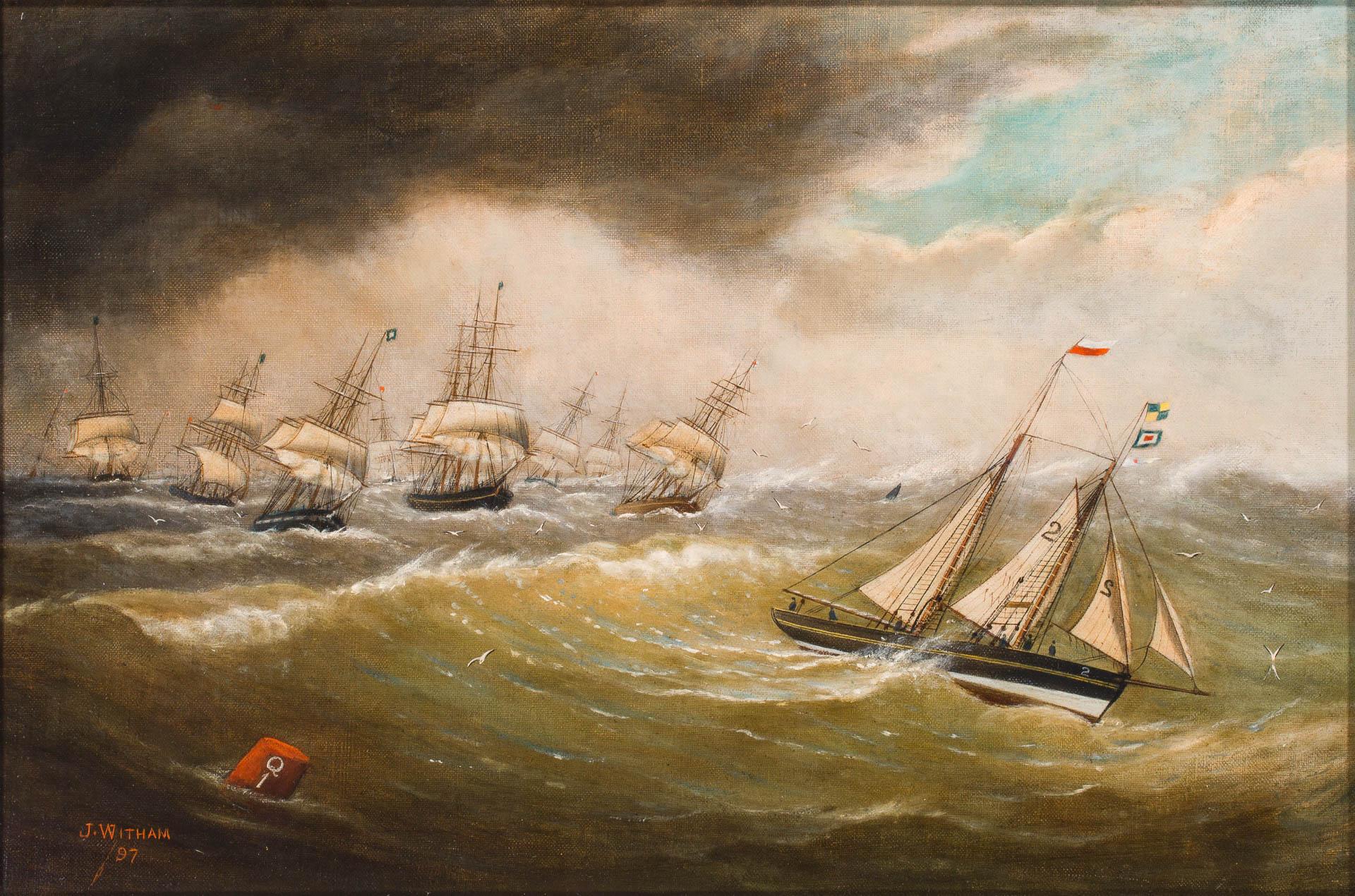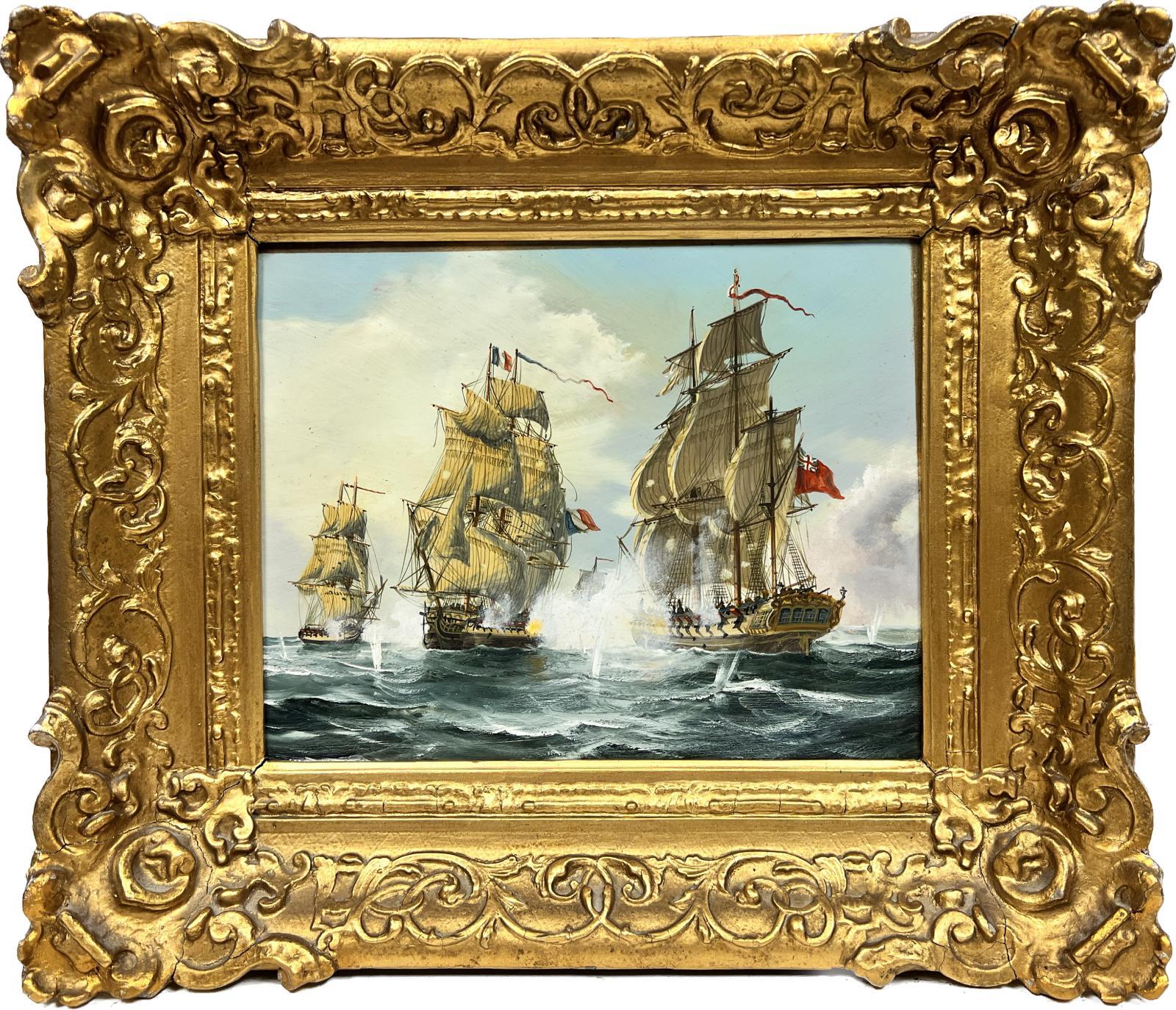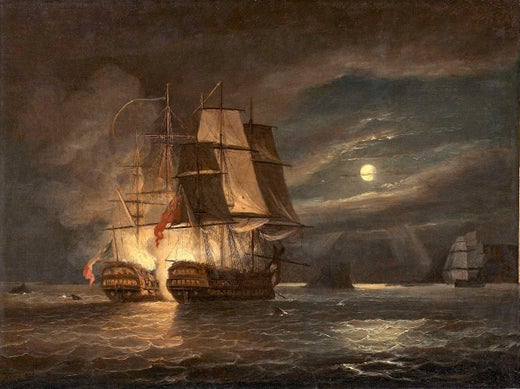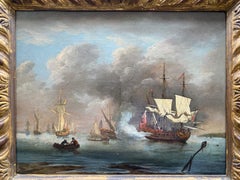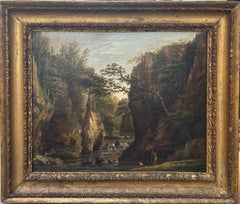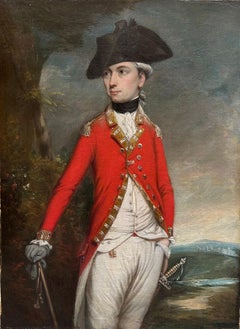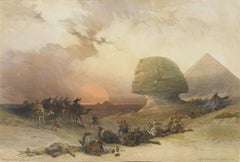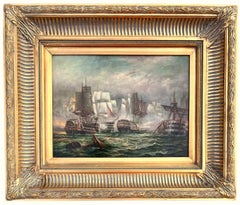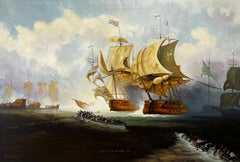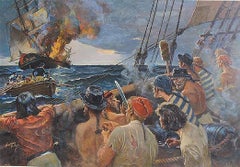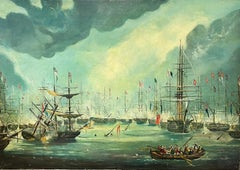Items Similar to The Battle of Raz de Sein
Want more images or videos?
Request additional images or videos from the seller
1 of 7
Thomas LunyThe Battle of Raz de Sein
$66,462.81
£48,572
€57,074.74
CA$92,639.85
A$100,683.58
CHF 53,207.34
MX$1,218,054.04
NOK 662,659.49
SEK 625,923.10
DKK 426,127.51
About the Item
Thomas Luny
1759-1837
The Battle of Raz de Sein
Oil on canvas, signed and dated 'Luny 1834' lower left
Image size: 15 1/4 x 20 1/8 inches (38.7 x 51.2 cm)
Provenance
The Parker Gallery, London
Private collection, England, and by descent.
This dramatic scene throws the viewer straight into the heart of a naval battle between the British ship HMS Mars and the French Hercule. The scene is only lit from two sources - one being the tranquil moon, and the other being violent flashes of canon fire between the two fighting ships. The moon penetrates from behind a thick cloud cover, accentuating the darkness and moody atmosphere of the work. It is an incredibly tense and atmospheric piece, truly demonstrating Luny's talents as a painter of marine battle scenes.
The 74-gun third-rate ship of the line Mars was built in the Deptford docks and launched on the 25th October 1794. She was initially assigned to the Channel Fleet, and on the 12th April 1798 sailed from St. Helens, Isle of Wight, with the Admiral Lord Bridport's squadron bound for Brest. Nine days later, whilst cruising in company with H.M.S. Ramillies and two frigates, the crew sighted two French vessels and an enemy warship and gave chase. After three hours of pursuit Mars brought the 74-gun Hercule to action. The two opposing 74s swiftly became entangled because of fouled anchor cables, and they opened fire on one another at 10:30 pm.
After a vicious engagement lasting two hours, Hercule could no longer withstand the attack and struck her colours shortly after midnight. The damage to both ships was substantial and loss of life was high, including that of the commander of the Mars, Captain Alexander Hood, a cousin to Lord Bridport. The damaged Hercule was taken back to Plymouth and repaired at a cost of £12,500, so extensive was the damage caused by the Mars' broadsides. She was eventually commissioned into the Royal Navy, retaining her original name.
Thomas Luny
Born in Cornwall, Thomas Luny was an English artist who primarily painted maritime scenes and seascapes.
Leaving for London in 1759, Luny became the apprentice of Francis Holman, a marine painter famous for his patriotic scenes of sea battles. Here, Luny developed his practice, with the lasting impressions left by Holman evident in Luny’s later maritime works through compositional and stylistic preferences. Luny temporarily left Holman’s studio in September 1777 to travel around France and to exhibit his painting “A Distant View of the Island of Madeira and Porto Santo” at the Society of Artists that same year, before returning to Holman’s studio. In 1780, he set up his own practice on Leadenhall Street in 1783.
Between 1780 and 1802, Luny exhibited twenty-nine times, and his work was frequently shown at the Royal Academy. With the success of his work, Luny used the money he earned to regularly invest in government stocks, helping to solidify his financial success as an artist.
His popularity was further accelerated by his studio’s position on Leadenhall Street, with its close proximity to the British East India Company’s headquarters leading to many commissions of paintings and portraits. This relationship was further beneficial to Luny, who is believed to have been invited on the company's ships, leading to his detailed and realistic sketches of locations within Europe and the Americas. Additionally, the location of his studio on Leadenhall Street developed a close relationship between Luny and an art dealer and framer called Mr. Merle, in which both parties promoted each other's work for over twenty years.
In 1807, several years later, Luny moved his studio again to Devon, where he received a number of commissions and continued to capture the same popularity that he experienced in London. Between 1808 and 1809, Luny solidified his position in Teignmouth, Devon, by building a house on the harbor front in Teign Street, which, while becoming known as Luny House, served as a significant part of his work in his later years. Though he was suffering from arthritis at this time in both of his hands, there was no obvious impact on his work due to his technique of strapping the paintbrush to his wrist, and he continued to be prolific, producing over 2,000 paintings during his time in Devon.
Luny died on the 30th of September, 1837, and was buried in the graveyard of St. James’ Church in Devon.
Exhibitions
Royal Academy of Art
Society of Artists
Museums
National Maritime Museum, Greenwich
Royal Albert Memorial Museum, Exeter
Mariners’ Museum, Virginia
Victoria and Albert Museum, London
Tate Gallery, London
Walker Art Gallery, Liverpool
National Gallery of Victoria, Australia
- Creator:Thomas Luny (1759-1837, British)
- Dimensions:Height: 15.25 in (38.74 cm)Width: 20.5 in (52.07 cm)
- Medium:
- Period:
- Condition:
- Gallery Location:London, GB
- Reference Number:1stDibs: LU52416777402
Thomas Luny
Thomas Luny was the son of Thomas Luny and his wife Elizabeth Wallace. He was probably born in Cornwall and was baptized at St Ewe near Mevagissey on 20th May 1759. His mother had a son from a previous marriage, Captain James Wallace (1754-1832), who served with Nelson at Copenhagen in 1801. By 1773 Luny was apprenticed to the marine painter Francis Holman (1729-1784), giving Holman’s address at Johnson Street, St George’s when he sent his first exhibit to the Society of Artists in 1777. In 1781/82 he moved to Ratcliffe Highway, Stepney. Luny exhibited at the Society of Artists again in 1778, at the Free Society in 1783, and sent pictures to the Royal Academy from 1780 to 1793. He painted London views, portraits of East Indiamen, and battle scenes. Luny exhibited no works between 1793 and 1802 and it was once thought that he served as a purser in the Royal Navy; this has now been discounted. His painting subjects suggest that he traveled, but there is no direct evidence for this except a visit to Paris in 1777. In 1791 he bought a property at 16 Mark Lane, between Leadenhall Street and the Thames, and by 1795 he was earning enough to invest regularly in government stocks. In mid-1807 he moved (probably for reasons of health) to Teignmouth, a fashionable watering-place on the Devon coast popular with retired naval officers. A number of them became friends and patrons, notably Captain George Tobin, an amateur artist. In 1808-9 he built a handsome house on the harbor front in Teign Street, later called Luny House. Luny was a prolific producer of Devon coastal views, shipping scenes, and naval events, despite suffering so severely from arthritis that he had to paint with the brush strapped to his wrist. He sent a Battle of the Nile to the Royal Academy in 1802 and three paintings in 1837, the year that there was an exhibition of 130 of his paintings in Old Bond Street. Luny died at Teignmouth on 30th September 1837. The work of Thomas Luny is represented in the National Maritime Museum, Greenwich; the Bristol City Art Gallery; Exeter Art Gallery; Swansea Museum; the Peabody Museum of Salem, Massachusetts and the Library of New South Wales, Sydney.
About the Seller
5.0
Vetted Professional Seller
Every seller passes strict standards for authenticity and reliability
Established in 2007
1stDibs seller since 2014
85 sales on 1stDibs
Typical response time: 3 hours
- ShippingRetrieving quote...Shipping from: London, United Kingdom
- Return Policy
Authenticity Guarantee
In the unlikely event there’s an issue with an item’s authenticity, contact us within 1 year for a full refund. DetailsMoney-Back Guarantee
If your item is not as described, is damaged in transit, or does not arrive, contact us within 7 days for a full refund. Details24-Hour Cancellation
You have a 24-hour grace period in which to reconsider your purchase, with no questions asked.Vetted Professional Sellers
Our world-class sellers must adhere to strict standards for service and quality, maintaining the integrity of our listings.Price-Match Guarantee
If you find that a seller listed the same item for a lower price elsewhere, we’ll match it.Trusted Global Delivery
Our best-in-class carrier network provides specialized shipping options worldwide, including custom delivery.More From This Seller
View AllFiring the Salute
By Peter Monamy
Located in London, GB
Oil on canvas
Image size: 19 1/2 x 15 1/2 inches (49 x 39.5 cm)
Original frame
This is a a wonderful marine scene depicting a flotilla of battleships, warships and Admiralty yachts....
Category
Early 18th Century Naturalistic Landscape Paintings
Materials
Canvas, Oil
$9,852
The Gorge
Located in London, GB
Attributed to George Barret Sr
The Gorge
Oil on canvas
Image size: 13 1/2 x 16 1/2 inches (34.5 x 42 cm)
Gilt frame
In this landscape, a river runs over rocks at the bottom of a cra...
Category
18th Century Paintings
Materials
Oil, Canvas
Portrait of Captain George Meek
Located in London, GB
William Roth
Born 1754
Portrait of Captain George Meek
Oil on canvas, signed & dated 1782 lower right
Image size: 25 x 18 ½ inches (64 x 47 cm)
Provenance
Murray Cassy
Jean Piere O...
Category
Late 18th Century Portrait Paintings
Materials
Canvas, Oil
Approach of the Simoon - Desert of Geezah, 19th Century Subscription Edition
By David Roberts
Located in London, GB
After David Roberts R.A. 1796 - 1864
Approach of the Simoon - Desert of Geezah
First Edition lithograph Full plate: 240
Presented in a acid free mount
An original 19th Century l...
Category
19th Century Landscape Prints
Materials
Lithograph
Open Seas, Late 19th Century
Located in London, GB
Oil on board
Image size: 14 3/4 x 11 3/4 inches (37.5 x 30 cm)
Contemporary hand made frame
A dramatic, and highly colourful, depiction of the crashing waves of the open seas.
The ...
Category
Late 19th Century English School Landscape Paintings
Materials
Oil, Board
The Battle of Flodden, English School Early 20th Century Oil, Knights
Located in London, GB
English School
1910
The Battle of Flodden
Oil on canvas, monogrammed and dated 1910 lower right
Image size: 25 x 50 inches (63.5 x 127 cm)
Original frame
Provenance
Dacre Castle
The Battle of Flodden or Flodden Field, sometimes called the Battle of Branxton was part of a conflict between England and Scotland. The Scots were allied with France and at the time of the battle Henry VIII was in France fighting there and had left his kingdom under the regency of his queen Catherine of Aragon.
The battle was fought in Branxton in Northumberland on 9 September 1513, between an invading Scots army under King James IV and an English army commanded by the seasoned warrior Thomas Howard, Earl of Surrey.
Invoking the Auld Alliance with France, James IV of Scotland crossed...
Category
Early 20th Century Figurative Paintings
Materials
Oil
You May Also Like
A Lively Naval Engagement
Located in Wiscasett, ME
Oil on panel measuring 21" x 24.5," including the frame. The painting is signed in the lower right corner, but we cannot attribute the signature. Probably dating from the late 19th ...
Category
Late 19th Century Old Masters Landscape Paintings
Materials
Oil
Very Large British Oil depicting famous Naval battle
Located in Cirencester, Gloucestershire
Artist/ School: British School, second half 20th century, signed lower left 'Champion'
Title: a copy after de Loutherbourg's 1795 painting of Lord Howe's action of 1 June 1794 in th...
Category
20th Century Victorian Landscape Paintings
Materials
Oil, Canvas
$1,642 Sale Price
20% Off
Pirates Destroying Ship
By Norman Mills Price
Located in Fort Washington, PA
Medium: Oil on Board
Signature: Signed Lower Right
Subject matter features pirates watching a ship burn from a distance a small rowboat with a figure returning to the ship after set...
Category
20th Century Figurative Paintings
Materials
Oil, Board
Naval Battle Engagement at Sea Large Busy Battle Scene Many Ships, Signed Oil
Located in Cirencester, Gloucestershire
English School, early 20th century
signed
oil painting on canvas, unframed
canvas: 17 x 24 inches
provenance: private collection, Eng;and
condition: good and sound condition, minor ...
Category
Early 20th Century Old Masters Landscape Paintings
Materials
Oil, Canvas
$1,532 Sale Price
20% Off
Follow the Leader
By Joseph Witham
Located in Costa Mesa, CA
The most important maritime center in the 19th century, Liverpool, had many advantages. Located on the England-facing west coast of the Irish Sea, the Mersey approach was wide, deep and actively associated with all aspects of shipping. It also faced northwest, as the distressed fleet in Witham's work has discovered on a stormy February 8, 1881.
To the rescue of the 12 ships, the Pilot Schooner No.2, LEADER, signals the fleet to follow, using the pre-1900 commercial code signals "l w c". She has waited for the rising tide and keeps the line tight to the red starboard buoy, Q1, which marks the beginning of the Queen's Channel. Within a span of hours, all twelve ships were led successfully to their docks.
Witham painted the scene in conjunction with the great acclaim the Pilots received in 1881, and it became so popular that he painted additional works marking the event over time. His local contemporary, Samuel Walters...
Category
1890s Other Art Style Paintings
Materials
Canvas, Oil
English School Oil Painting Napoleonic Wars Naval Engagement Battle at Sea
Located in Cirencester, Gloucestershire
Contemporay English School
signed oil painting on copper panel in impressive gilt frame
framed: 13 x 14.5 inches
panel: 8 x 10 inches
provenance: private collection, England
conditi...
Category
20th Century Modern Landscape Paintings
Materials
Oil
